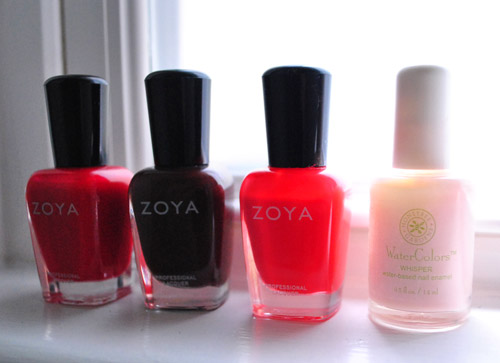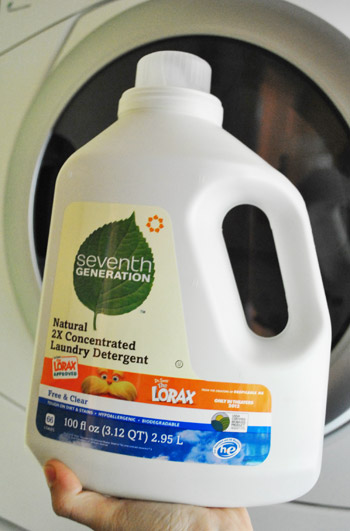After my recent porch chair makeover, it occurred to me that as a frequent DIYers, John and I probably expose ourselves to a fair amount of chemicals. And the fact that I actually felt woozy and nauseous after ten minutes of spray painting made me wonder just how bad these toxic chemicals really could be. Were the effects only temporary or were we setting ourselves up for some serious health issues down the line? A few moments of picturing us in our perfectly painted & stained home on ventilators was all it took to iron out my priorities: health before home improvement.
So I thought to myself: self, there’s gotta be a way to keep unnecessary chemicals out of our house (and our lungs). So I did a little digging to uncover a few easy switcheroos that could make our house a little safer for us, our beloved poochkins, and the future bambinos. Here’s what I learned:
– Nail polish and nail polish remover are one of the most toxic, carcinogenic products in the house (assuming you keep all your paint, varnish and stain in a detached garage or shed like we do- or use low VOC or no-VOC paints). If giving up the ol’ mani-pedi just isn’t an option, Zoya nailpolish is a water-based organic substitute that’s thankfully carcinogen free (OPI is the world’s worst kind- dripping with formaldehyde, a known cancer causer). And when it comes to nailpoish remover, choosing something that’s acetone free is the way to go (and removing your polish outside keeps other chemicals from hanging around the house for days).

-Topical flea and tick products for your pets (like Advantage or Advantix) are extremely dangerous for children, people in general and even pets (!) – they’re loaded with carcinogenic pesticides and each box has serious warnings about washing your hands thoroughly if you come in contact with the product. We don’t know about you, but each month that we put Burger’s medication on the back of his neck we would accidentally pet him while it was still wet, he’d sit on our couch with it, it would get on our clothes, etc. In essence that dangerous chemical was getting all over our house each month… and we were putting it on our beloved dog! Not anymore. It’s in the trash and our pup (who has never had a flea problem and spends most of his time indoors) is going chemical free. And if he should have an issue, flea and tick shampoos are much less harsh than pesticides (they’re actually called that on the box) like Advantage and Advantix.
– Bleach and ammonia riddled cleaning products are another completely toxic component, which not only pollute your home when you use them but also off-gas (ie: leak into the air) even when they’re stored under the sink. Thankfully, we gave up bleaching our whites a while ago so we didn’t have a big bottle of bleach to get rid of. But we did use some pretty smelly shower spray (Tilex mildew stuff) so we happily made the switch to Mrs. Meyers Shower Cleaner, which is about a million times better for our lungs and still beats any mildew that rears its ugly head. We also grabbed another all purpose cleaning product from Mrs. Meyers for wiping down glass and other surfaces without harsh chemicals of any kind. Easy peasy (and we love that it’s non-toxic just in case Burger gets a lick here or there).
– I also read numerous reports of people switching to a less chemically enhanced laundry detergent and immediately noticing that going back to Tide or Cheer gave them rashes. Sounds like switching to something milder and sticking to it would be good for us and our babies down the line. So we grabbed some über gentle Seventh Generation Concentrated Laundry Detergent. And we ditched fabric softener altogether (which is also another great way to cut down on chemicals that you wear and breathe every day). The result is still fresh, clean and soft clothes (which makes me wonder if fabric softener really does anything anyway). Really, we didn’t even notice the change (but we’re sure our unborn children will thank us).

– Just to be overachievers, while at Target we also grabbed Tom’s Of Maine Natural Whole Care toothpaste (with fluoride), made with all natural ingredients like peppermint oil. We figured that making that switch now would make it easier for us to pass our healthy habit to our children (who swallow gobs of toothpaste in their younger years). Honestly, this change was something we noticed. The first few days we thought it seemed a little gritty compared to our old toothpaste. But we’ve totally adapted and love the stuff now. And we’ve both noticed that the peppermint oil keeps our mouths feeling clean and smelling fresh longer than the fake flavoring of other brands. Oh and we’ve also switched to natural deodorant without aluminum or phosphates (Tom’s of Maine). Now we’re so fresh and so green.
And now for a few other tips:
-Completely eliminate pesticides (bug bombs in your home, flea and tick pet treatments, lawn pesticides and herbicides, etc)- according to CancerIQ.org the risk of leukemia increases by four to seven times for children ten or under who use home or garden pesticides, and they can also be linked to childhood brain cancer. Yikes!
-Remove the plastic from dry cleaning garments and let them air out outside, in your sunroom, or on your porch for 24 hours before bringing them into your home.
-Choose floss and natural toothpaste over mouthwash (which has a whole buncha chemicals- why do you think you’re not supposed to swallow it?).
-There are a slew of non-toxic, natural, and chemical free products available thanks to Seventh Generation (from dish detergent and hand soap to diapers and even tampons!).
– Limit radiation exposure by avoiding x-rays unless necessary (broken bone= necessary, annual dentist appointment= not necessary).
– Never ever ever heat plastics (packaging that comes with tv dinners, plastic wrap, or tupperware) in the microwave and only use ceramic or glass containers that are microwave safe (carcinogens can leak from the plastic products into you food).
Of course you don’t have to follow all of our above suggestions, and we might have lost you at ditching OPI nail polish, but we love to share what goes on in this young house, and this proved to be a pretty interesting learning experience for us. We’re regularly buying all of these products anyway (from deodorant to dish detergent) so selecting the healthiest options seem like a worthwhile pursuit since we use ’em every day on the only body we get. We also found an extremely helpful website called greenyour.com, which offers actual products to snag (as opposed to a list of what not to buy) when you click the “product” tab in each category. Oh and remember to dispose of any chemicals that you’re removing from your home (paint, bleach, etc) in a safe way, like dropping them off at your local recycling center in the designated toxic chemical area.
And so we (finally) conclude our super long post. Long live longer living!

Andrea says
My daughter introduced me to your website and I am now a devotee. Loved this information.Regarding heating of plastics, if you car has been sitting in the heat, open the windows for a minute or two to help the toxic fumes dissipate. As for the microwave, I have understood that microwaving changes the chemical structure of food. Just heat a cup of water on the stove and one in the microwave and compare the taste. It tastes different to me. Lastly, our skin absorbs all of these toxins that we put on it so I never use lotions anymore. Can you imagine how toxic it is to apply sunscreen and bug repellant to our skin? I know there are some healthy choices out there for us but we sure have to be vigilant.
Kate says
I just love poking around your site. This is such a helpful article! I’ve started using lemons, baking soda, vinegar, and salt around the house – they work wonders!! This is the book that got me started:
http://www.amazon.com/Salt-Lemons-Vinegar-Baking-Soda/dp/B002NLNFJ2/ref=sr_1_5?ie=UTF8&qid=1328645076&sr=8-5
For some reason it’s really expensive on Amazon, I think it’s cheaper at Barnes & Noble. (They probably published it.) Happy Green Cleaning!
YoungHouseLove says
Aw thanks for the tip Kate!
xo,
s
Jessica says
I know this is an OLD post and I kinda feel like I’m YHL stalking you after trying to play catch-up on years’ worth of blog posts in the last few weeks, BUT. . . in this post you talk about getting rid of bleach and how you stopped using bleach for you white laundry long before this post. I’m just curious how you get your whites white without the use of bleach. My dish towels, especially, take a beating with stains that sometimes even bleach can’t remove. (Bonus points for avoiding paper towels, though, I guess). Lately I’ve been noticing my whole family get skin irritation after wearing whites, so what’s your secret? I apologize in advance if you covered this in a later blog post that I haven’t yet discovered.
Jessica says
I should add that if you haven’t covered that in a blog post and you’re short on ideas one week, you have at least one reader who would be interested in the topic. :)
YoungHouseLove says
Thanks Jessica! We just cut it out and for white loads we just use oxyclean when necessary. Although I have to admit that our washer and dryer are great (new and low-e) so they seem to clean things well just with white vinegar or all natural detergents like Seventh Generation free & clear (so we don’t use oxyclean very often at all). I’ve actually noticed that things like white towels and sheets seem to stay brighter and whiter without bleach (bleach seemed to yellow them, and not using it keeps things more clear looking and less faded if that makes sense). Hope it helps!
xo
s